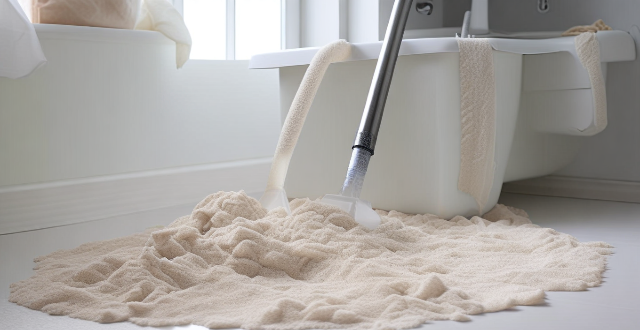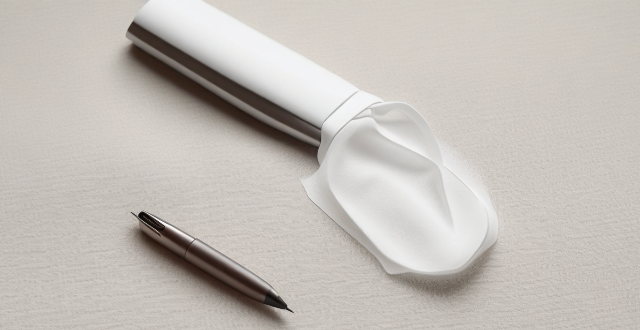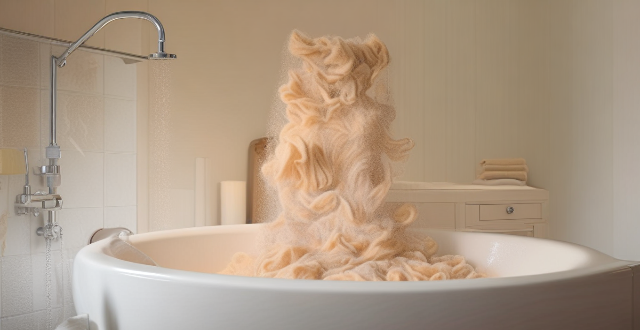Stain Area

Can vinegar be used as a natural stain remover for clothes ?
Vinegar can be used as a natural stain remover for clothes due to its acidic properties and antimicrobial benefits. It is effective in removing various types of stains, including grass, blood, wine, coffee, tea, and sweat. To use vinegar as a stain remover, apply it directly to the stain, let it sit for 5-10 minutes, scrub gently, rinse with cold water, and wash according to care label instructions. Vinegar is cost-effective, environmentally friendly, and versatile. However, it should be tested on an inconspicuous area before use and avoided on delicate fabrics.

Are there any DIY tricks for getting out tough stains like blood or grass ?
When it comes to removing tough stains like blood or grass, there are several DIY tricks you can try before resorting to professional cleaning services. These include soaking the stained area in cold water, applying hydrogen peroxide directly to the stain, creating a paste with salt and cold water, applying white vinegar directly to the stain, mixing lemon juice with salt to create a paste, and mixing dish soap with baking soda to create a paste. It is important to always test any solution on an inconspicuous area of the fabric first to ensure it doesn't cause damage or discoloration. If these DIY methods fail, consider seeking professional help from a cleaning service.

How do I remove stubborn stains from carpets and upholstery ?
Removing stubborn stains from carpets and upholstery requires identifying the type of stain, acting quickly, pre-treating, gently blotting or scrubbing, rinsing and drying thoroughly, and possibly seeking professional help. Testing cleaning solutions on an inconspicuous area before use is recommended to avoid damage or discoloration.

What is the most effective method for removing wine stains from fabric ?
The most effective method for removing wine stains from fabric involves acting quickly, blotting the stain, applying salt and a stain remover, rinsing with cold water, washing the fabric, and checking the stain before drying.

Is there a natural way to clean stains off my clothes ?
Removing stains from clothes can be challenging, but natural methods like using white vinegar, baking soda, lemon juice, hydrogen peroxide, and salt can effectively clean various types of stains. These techniques are gentle on the environment and clothing.

How do I remove ink or pen marks from my clothing ?
Removing ink or pen marks from clothing can be challenging, but with the right techniques, it's often possible. Identify the type of ink, act quickly to blot wet ink, pre-treat the stain using appropriate methods for water-based, oil-based, or permanent marker ink, machine wash following care label instructions, check the stain before drying, and dry according to care label instructions. Always test cleaning solutions on an inconspicuous area first and consider professional cleaners for delicate or valuable garments. Patience and persistence are key when dealing with stubborn stains.

Is it possible to remove rust stains from fabric without damaging it ?
Rust stains can be removed from fabric using natural ingredients such as lemon juice and salt, vinegar and baking soda, or hydrogen peroxide. These methods are effective in breaking down the rust and lifting it away from the fabric without causing damage. It is important to test any cleaning solution on a small area of the fabric before applying it to the stain and to allow enough time for each method to work. If one method does not work, try another one until the stain is completely removed. After removing the rust stain, wash the fabric according to its care instructions to remove any residual cleaning solution and prevent further damage.

How can I get rid of grease stains on my favorite shirt ?
Removing grease stains from your favorite shirt can be a daunting task, but with the right techniques and products, it is possible to get rid of these unsightly blemishes. Here are some steps you can follow to remove grease stains from your favorite shirt: 1. Act Quickly: The first step in removing grease stains is to act quickly. The longer the stain sits on your shirt, the harder it will be to remove. As soon as you notice the stain, take action to remove it. 2. Blot the Stain: Use a clean cloth or paper towel to blot the stain gently. Do not rub the stain aggressively, as this can spread the grease further into the fabric. Instead, apply gentle pressure to absorb as much of the grease as possible. 3. Apply a Stain Remover: Apply a stain remover specifically designed for grease stains. You can use a commercial stain remover or make your own by mixing equal parts of dish soap and white vinegar. Apply the solution directly to the stain and let it sit for 5-10 minutes. 4. Wash the Shirt: After allowing the stain remover to sit on the stain, wash the shirt in cold water using a laundry detergent that contains enzymes. Enzymes are effective at breaking down grease and oil, making it easier to remove the stain. Avoid using hot water, as this can set the stain permanently. 5. Check the Stain: Before drying the shirt, check to see if the stain has been removed. If the stain is still visible, repeat steps 3 and 4 until the stain is completely gone. Do not dry the shirt until the stain is completely removed, as heat can set the stain permanently. 6. Dry the Shirt: Once the stain is removed, dry the shirt according to the care label instructions. If you are unsure about the care instructions, it is best to air dry the shirt or use a low heat setting on your dryer. In conclusion, removing grease stains from your favorite shirt requires quick action, the right products, and patience. By following these steps, you can effectively remove grease stains and keep your favorite shirt looking its best.

What's the best way to treat set-in stains on white clothing ?
Set-in stains on white clothing can be stubborn and difficult to remove, but with the right approach, they can often be successfully treated. Here are some steps to follow: 1. Identify the Stain: First, identify the type of stain you are dealing with. Different stains require different treatments. For example, protein stains like blood or grass require a different approach than tannin stains like tea or coffee. 2. Act Quickly: The sooner you treat a stain, the easier it is to remove. If the stain is still wet, blot it with a clean cloth or paper towel to remove as much of the substance as possible. 3. Pre-Treat the Stain: Before washing, pre-treat the stain with a suitable stain remover. Choose a product that is safe for use on white clothing and apply it directly to the stain following the instructions on the label. Let it sit for the recommended time. 4. Wash in Hot Water: Wash the garment in hot water, using a detergent that is designed for white clothing. Check the care label on your garment to ensure that it can be washed in hot water. If not, use the warmest water recommended. 5. Use Chlorine Bleach if Necessary: If the stain persists after washing, you can use chlorine bleach. However, be sure to check the care label on your garment first. Some fabrics may not be able to handle bleach. If your garment is made of a material that can be safely bleached, add chlorine bleach to the wash cycle according to the package instructions. 6. Rinse Thoroughly: Rinse the garment thoroughly to remove all traces of the stain and any cleaning products used. 7. Dry and Check: Dry the garment and check to see if the stain has been removed. If not, repeat the process before drying again. Once the stain is gone, you can dry the garment as usual. In conclusion, treating set-in stains on white clothing requires patience and persistence. By identifying the stain, acting quickly, pre-treating, washing in hot water, using chlorine bleach if necessary, rinsing thoroughly, drying, and checking, you can often successfully remove even the most stubborn stains.

What are the best ways to remove stains from clothes ?
Removing stains from clothes requires pre-treatment, stain removers, home remedies, laundry detergent, and sometimes professional dry cleaning. Pre-treating the stain by blotting it with a clean cloth or paper towel is crucial. Commercial stain removers can be effective for various stains, while home remedies like baking soda and vinegar, hydrogen peroxide, and lemon juice can tackle stubborn stains. Applying laundry detergent directly to the stain and washing it afterward can also work. For delicate fabrics or persistent stains, professional dry cleaning may be necessary. By following these steps, most types of stains can be effectively removed from clothing.

Is fiber optic broadband available in my area ?
Fiber optic broadband is becoming increasingly popular due to its high speed and reliability. However, the availability of fiber optic broadband depends on the area you live in. In this article, we will discuss how to check if fiber optic broadband is available in your area. The first step is to check with your current internet service provider (ISP) if they offer fiber optic broadband in your area. You can contact them through their website or customer service hotline. They should be able to provide you with information about the availability of fiber optic broadband in your area. There are several online tools that can help you determine if fiber optic broadband is available in your area. One such tool is the [National Broadband Map](https://www.broadbandmap.gov/), which provides detailed information about broadband availability across the United States. Another tool is the [Google Fiber Checker](https://fiber.google.com/cities/), which allows you to enter your address and see if Google Fiber is available in your area. Local government agencies may also have information about the availability of fiber optic broadband in your area. You can contact your city or county government office and ask if they have any information about fiber optic broadband providers in your area. If you have friends or neighbors who use fiber optic broadband, you can ask them if they know of any providers in your area. They may be able to provide you with valuable information about the availability of fiber optic broadband in your area. In conclusion, checking the availability of fiber optic broadband in your area can be done by contacting your ISP, using online tools, checking with local government agencies, and asking your neighbors. By following these steps, you can determine if fiber optic broadband is available in your area and choose the best provider for your needs.

How can I quickly clear out and organize my desk area ?
Clearing out and organizing your desk area is a task that requires both physical effort and mental clarity. Here are some steps to help you get started: ### Step 1: Remove everything from your desk First, take everything off your desk. This includes papers, pens, books, electronic devices, and any other items that may be cluttering up your workspace. - Papers: File them away or recycle them if they are no longer needed. - Pens and pencils: Place them in a cup or holder. - Books: Store them on a nearby shelf or in a cabinet. - Electronic devices: Unplug them and store them in a safe place. ### Step 2: Clean your desk Once everything is off your desk, it's time to clean it. Use a damp cloth to wipe down the surface of your desk, being sure to get into all the nooks and crannies. If there are any stubborn stains, use a small amount of soap and water to remove them. ### Step 3: Organize your space Now that your desk is clean, it's time to start organizing your space. Here are some tips: - Create zones: Designate specific areas for different tasks. For example, one side of your desk could be for writing and another for computer work. - Use storage containers: Invest in some storage containers or drawer dividers to keep small items organized. - Label everything: Label folders, boxes, and drawers so you know where everything goes. - Keep only what you need: Don't let unnecessary items clutter up your workspace. Only keep what you need within arm's reach. ### Step 4: Maintain your organization Finally, it's important to maintain your newly organized desk area. Make sure to put things back where they belong after each use, and take a few minutes at the end of each day to tidy up your workspace. By doing this, you'll be able to keep your desk area clean and organized for years to come!

How can I streamline my laundry process to be more productive ?
Streamlining your laundry process can save time and reduce stress. Here are some tips to help you be more productive with your laundry tasks: 1. **Preparation Phase**: - Gather all necessary laundry supplies like detergent, fabric softener, and stain removers. - Sort clothes by color and fabric type. - Establish a routine for doing laundry and use proper storage for dirty and clean clothes. 2. **Washing Cycle**: - Avoid overloading the washing machine and separate heavy items from delicates. - Choose the appropriate wash cycle based on soil levels and adjust water temperature for energy efficiency. 3. **Drying Process**: - Dry similar items together and clean the lint screen after every use to improve dryer efficiency. - Use timed drying to avoid overdrying and fold clothes immediately to prevent wrinkles. 4. **Organization and Maintenance**: - Fold or hang clothes immediately after drying to reduce wrinkling and put away clean clothes to avoid clutter. - Keep the laundry area clean by wiping down surfaces after each use and regularly cleaning the washing and drying machines. By implementing these steps, you can make your laundry process more efficient, saving time and effort in the long run.

What are the best restaurant deals in my area ?
Finding the best restaurant deals in your area can be a fun and rewarding experience. Here are some tips on how to find the best deals near you: check local listings, follow social media, sign up for newsletters, use restaurant review websites, and ask friends and family for recommendations.

How can I discover new cycling routes in my area ?
Finding new cycling routes can be an exciting adventure. Here are several ways to discover new cycling routes in your area: 1. Use cycling apps and websites like Strava, Komoot, Ride with GPS, and Bikemap. 2. Join local cycling groups through Meetup, cycling clubs, or Facebook groups. 3. Check with local bike shops for route recommendations and group rides. 4. Look at city or county parks departments for maps and events showcasing new routes. 5. Ask friends and family for hidden gem routes and join their rides. 6. Explore on your own by scouting detours on familiar rides and using maps. 7. Attend cycling events like road races and bike festivals to learn about new routes. 8. Use Google Maps to plan custom routes and spot potential paths in satellite view. 9. Check out local guidebooks on cycling in your region at bookstores or the library. 10. Visit local tourist information centers for brochures and advice on scenic routes. By utilizing these methods, you can expand your cycling horizons and enjoy the thrill of discovering new routes in your area while riding safely and respecting the rules of the road and trail.

Can you recommend a good Japanese restaurant in my area ?
The text provides recommendations for finding a good Japanese restaurant in one's area. It suggests checking online reviews, asking locals for recommendations, looking for specialties, and considering the ambiance. The steps to follow include searching online, making a list of potential restaurants, narrowing down options, calling ahead, and trying them out. The author encourages readers to enjoy their culinary adventure and discover personal favorites.

What are the best mobile operators in my area ?
Choosing the best mobile operator in your area requires careful consideration of several factors, including coverage, data speeds, pricing, customer service, and network reliability. Some of the best options based on these criteria are Verizon, AT&T, and T-Mobile. Each operator has its own strengths and weaknesses, so it's important to do your research and choose the one that best meets your needs and budget.

What are some quick and easy ways to get my clothes clean ?
Here are some quick and easy ways to keep your wardrobe fresh and clean: 1. Spot Cleaning: For small stains or spills, dampen a cloth with water or a mild detergent and gently blot the affected area until the stain is removed. 2. Hand Washing: Fill a sink or basin with warm water and add a small amount of gentle detergent. Gently agitate clothing items in the water, then rinse thoroughly and hang to dry. 3. Machine Washing: Sort clothes by color and fabric type before washing. Use a gentle cycle and cold water for delicate items, and warmer water for more durable fabrics. 4. Dry Cleaning: Check care labels on garments made from silk, wool, or other delicate materials. If dry cleaning is recommended, take clothes to a professional dry cleaner. 5. Air Drying: Hang clothes outside on a clothesline or indoors on a drying rack to save energy and prolong their lifespan. This method also helps eliminate wrinkles and static cling. 6. Steaming: Hang clothes in a steamy bathroom after a shower or use a handheld garment steamer to remove wrinkles and odors. By incorporating these methods into your routine, you can keep your wardrobe looking its best without spending hours on laundry day.

How can I stay informed about potential disasters in my area ?
In the text, the author discusses the importance of staying informed about potential disasters in one's area and provides steps to achieve this. The key takeaways are that knowledge is power, timely information can make a significant difference in safety and damage control, and being informed helps contribute positively to community preparedness efforts. The steps to stay informed include identifying local alert systems such as local government websites and apps, the National Weather Service, and emergency management agencies. Subscribing to alert services like Wireless Emergency Alerts, NOAA Weather Radio, and email newsletters and text messages from local authorities is also recommended. Social media and news sources can provide real-time updates, but it is important to ensure that the information comes from a verified source to avoid misinformation. Community networks such as neighborhood watch groups, town hall meetings, and volunteering for local emergency response teams can also provide valuable information. Regular updates and drills, such as reviewing and updating personal and family emergency plans, participating in local evacuation drills or safety exercises, and taking advantage of educational resources like FEMA's "Are You Ready?" campaign, can help individuals stay informed and prepared for potential disasters. Overall, the text emphasizes the importance of staying informed about potential disasters in one's area and provides practical steps to achieve this goal.

How do I find out about upcoming brand sale events in my area ?
Finding Upcoming Brand Sale Events in Your Area: - Follow brands on social media, subscribe to newsletters, check retailer websites, and local newspapers/magazines. - Use deal websites/apps, join brand loyalty programs, network with friends/family, and check community boards. - Set up Google Alerts for brands and visit outlet stores frequently.

What are the best ways to wash clothes quickly and effectively ?
This article discusses the best ways to wash clothes quickly and effectively. It covers preparation steps such as sorting clothes, pre-treating stains, and checking pockets. It also explains how to set up a washing machine with the right cycle, warm water, and detergent. Handwashing clothes is another option that involves soaking clothes in warm water with detergent, scrubbing gently, rinsing thoroughly, and hanging to dry. After washing, drying clothes properly is important to prevent wrinkles and damage. Overall, following these steps can help you save time and keep your clothes clean and fresh.

How can I find a sports club or group in my area to join ?
Finding a sports club or group in your area can be an exciting and rewarding experience. To help you find one, follow these steps: 1. Determine your interests by identifying the sports or activities that interest you. 2. Research online using directories like Sports Club Finder, Meetup, and Facebook Groups. 3. Check local recreation centers and parks for available options. 4. Ask friends, family members, or coworkers for recommendations. 5. Attend local sporting events to interact with other athletes and learn about nearby clubs. 6. Join online forums and social media groups dedicated to specific sports. 7. Be open to trying new things and exploring different sports or activities.